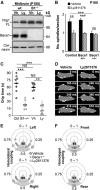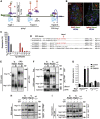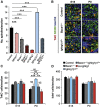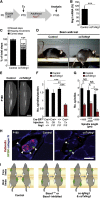Bace1 and Neuregulin-1 cooperate to control formation and maintenance of muscle spindles
- PMID: 23792428
- PMCID: PMC3715864
- DOI: 10.1038/emboj.2013.146
Bace1 and Neuregulin-1 cooperate to control formation and maintenance of muscle spindles
Abstract
The protease β-secretase 1 (Bace1) was identified through its critical role in production of amyloid-β peptides (Aβ), the major component of amyloid plaques in Alzheimer's disease. Bace1 is considered a promising target for the treatment of this pathology, but processes additional substrates, among them Neuregulin-1 (Nrg1). Our biochemical analysis indicates that Bace1 processes the Ig-containing β1 Nrg1 (IgNrg1β1) isoform. We find that a graded reduction in IgNrg1 signal strength in vivo results in increasingly severe deficits in formation and maturation of muscle spindles, a proprioceptive organ critical for muscle coordination. Further, we show that Bace1 is required for formation and maturation of the muscle spindle. Finally, pharmacological inhibition and conditional mutagenesis in adult animals demonstrate that Bace1 and Nrg1 are essential to sustain muscle spindles and to maintain motor coordination. Our results assign to Bace1 a role in the control of coordinated movement through its regulation of muscle spindle physiology, and implicate IgNrg1-dependent processing as a molecular mechanism.
Conflict of interest statement
The authors declare that they have no conflict of interest.
Figures







References
-
- Baskin YK, Dietrich WD, Green EJ (2003) Two effective behavioral tasks for evaluating sensorimotor dysfunction following traumatic brain injury in mice. J Neurosci Methods 129: 87–93 - PubMed
-
- Birchmeier C (2009) ErbB receptors and the development of the nervous system. Exp Cell Res 315: 611–618 - PubMed
Publication types
MeSH terms
Substances
Grants and funding
LinkOut - more resources
Full Text Sources
Other Literature Sources
Molecular Biology Databases

